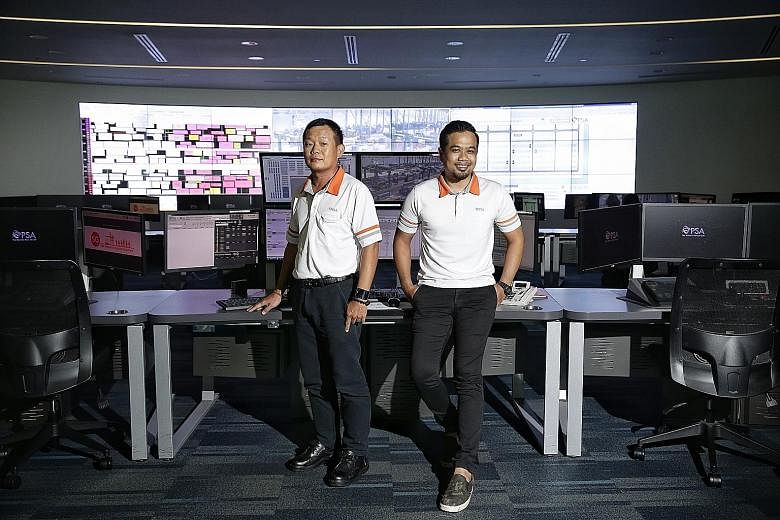When PSA employee Kenny Tan was told to move from Tanjong Pagar Terminal to the newer Pasir Panjang Terminal last August, he was not quite sure what to expect.
After all, the 51-year-old had been working at Tanjong Pagar Terminal for nearly three decades, manually driving cranes that pick containers up from trucks and move them into the yard, and vice versa.
Mr Tan today operates automated yard cranes as a container equipment specialist at the control centre. He takes over the controls only when there are exceptional cases to be handled - for example, when an automated yard crane is unable to read a container number.
"I was quite apprehensive at first because this (new) job is totally different," he told The Straits Times (ST). "But when I came here, my mentor trained and guided me throughout the process. I didn't feel there was a lot of difficulty in picking up the new skills."
Mr Tan spent three weeks at a training and reskilling programme - as part of PSA's move to relocate operations in the city terminals to Pasir Panjang Terminal - before obtaining certification to operate the automated yard cranes.
He noted that the new role has allowed him to be "more well-prepared for the changing world which requires less manpower, more automation".
"I'm now also working in a much more comfortable office environment, and I get to interact with my colleagues and superiors," Mr Tan said. "In the past, it was just me working alone inside a crane cabin. Communication was only through the radio set. Sometimes, we didn't even know who we were talking to."
The push for automation in an increasingly digitalised world has not excluded ports globally. But even as automation could mean cleaner, more efficient and less costly operations, it has inevitably sparked fears that port workers could be rendered obsolete.
For PSA, at least, readying its workforce for the future is high on the agenda. The port operator has relocated all of its 500 staff from Tanjong Pagar Terminal to Pasir Panjang Terminal in a process that involved reskilling and upskilling for its workers. No one was retrenched.
A PSA corporate spokesman said the latest Pasir Panjang Terminal as well as the future Tuas port will be "highly automated and driven by highly intelligent systems". "The new jobs that are being created will require a higher level of skill and knowledge," he said. "As our front-line roles continue to evolve, our staff will reskill for new roles and job scopes. They will also learn skills to operate new equipment. For example, they will move from operating single machines to using cutting-edge systems to manage the operations of a range of equipment and automated machines."
The spokesman added that PSA will bring more engineering and information communication technology roles into its fold as it equips staff with new competencies related to systems engineering and data analytics.
The Government at this year's Budget debate had said that some 13,000 new jobs could be created in the air and sea transport sectors by 2025 as Singapore builds smarter ports and develops vibrant enterprise ecosystems.
"A skilled maritime workforce is key to powering the growth of Singapore's maritime industry," Maritime and Port Authority of Singapore (MPA) chief executive Andrew Tan told ST.
He added that the MPA is working closely with industry stakeholders to "transform and create higher value-added jobs for Singaporeans" under the Industry Transformation Map for the sea transport sector, to be rolled out next year.
For Mr Mohamed Khairul, 30, another PSA employee, the move towards automation has helped boost his career.
Mr Khairul moved up the ranks when he transferred from Tanjong Pagar Terminal to Pasir Panjang Terminal last October - from a prime mover driver to an operations controller now, overseeing the operations of the automated yard cranes and supervising automated yard crane operators.
"It was a big change, from driving a truck to facing computer monitors. But there's some progression in my career, new things to learn, so I'm actually quite excited."


